Deck 3: Population
Question
Question
Question
Question
Question
Question
Question
Question
Question
Question
Question
Question
Question
Question
Question
Question
Question
Question
Question
Question
Question
Question
Question
Question
Question
Question
Question
Question
Question
Question
Question
Question
Question
Question
Question
Question
Question
Question
Question
Question

Unlock Deck
Sign up to unlock the cards in this deck!
Unlock Deck
Unlock Deck
1/40
Play
Full screen (f)
Deck 3: Population
1
In the figure, the green square represents 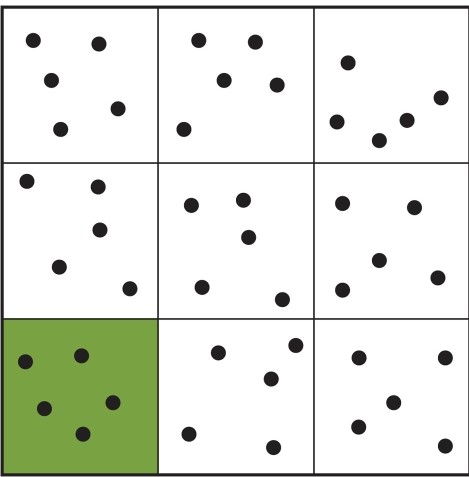
A)all the black dots in the figure.
B)industrial area for a country.
C)arable (or agricultural) land.
D)where most people live.

A)all the black dots in the figure.
B)industrial area for a country.
C)arable (or agricultural) land.
D)where most people live.
C
2
Based on the figure, the population of Brazil today can be described as 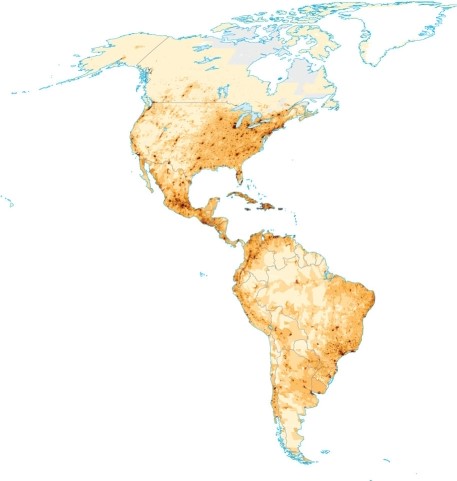
A)equally spread throughout the country.
B)clustered mainly around the capital of Brasilia.
C)tightly arranged along the coasts in an ex-colonial pattern.
D)moving rapidly into the Amazon rainforest as it is cleared for soy farming.

A)equally spread throughout the country.
B)clustered mainly around the capital of Brasilia.
C)tightly arranged along the coasts in an ex-colonial pattern.
D)moving rapidly into the Amazon rainforest as it is cleared for soy farming.
C
3
The total fertility rate (TFR) is
A)about equivalent to how many children are generally born in a region.
B)how many children on average a woman will have for a region during her childbearing years.
C)how many total women participate in reproduction in a country.
D)how many women in a country are fertile and can have children.
A)about equivalent to how many children are generally born in a region.
B)how many children on average a woman will have for a region during her childbearing years.
C)how many total women participate in reproduction in a country.
D)how many women in a country are fertile and can have children.
B
4
In northern Africa, the Nile River
A)shows up as a dark streak of intensely high population density.
B)is important because it is longer than the Amazon.
C)is the center of a broad population area stretching far away from the river itself.
D)is relatively short and devoid of many people.
A)shows up as a dark streak of intensely high population density.
B)is important because it is longer than the Amazon.
C)is the center of a broad population area stretching far away from the river itself.
D)is relatively short and devoid of many people.

Unlock Deck
Unlock for access to all 40 flashcards in this deck.
Unlock Deck
k this deck
5
China's population
A)is about the same in size and characteristics to Japan's.
B)is found on the main island in isolated lowlands around the mountainous interior.
C)is in an area fed by the Yellow and Yangtze Rivers, thus is very agricultural.
D)is growing the slowest of any country in the world.
A)is about the same in size and characteristics to Japan's.
B)is found on the main island in isolated lowlands around the mountainous interior.
C)is in an area fed by the Yellow and Yangtze Rivers, thus is very agricultural.
D)is growing the slowest of any country in the world.

Unlock Deck
Unlock for access to all 40 flashcards in this deck.
Unlock Deck
k this deck
6
The main difference between arithmetic and physiologic densities is
A)the difference between highland and lowland populations.
B)arithmetic is an actual head count while the other relates to industry.
C)arithmetic relates to total area, while physiologic only to arable cropland.
D)the first is people who cannot do math while physiologic relates to those who lean toward medical pursuits.
A)the difference between highland and lowland populations.
B)arithmetic is an actual head count while the other relates to industry.
C)arithmetic relates to total area, while physiologic only to arable cropland.
D)the first is people who cannot do math while physiologic relates to those who lean toward medical pursuits.

Unlock Deck
Unlock for access to all 40 flashcards in this deck.
Unlock Deck
k this deck
7
The basic demographic equation essentially says that future population is determined by
A)how much food there is in a region plus the amount of civil unrest.
B)physical turmoil (earthquakes and tsunamis) minus the effects of good soil.
C)how quickly people tend to repopulate an area and move around in it.
D)how many people are born and die and how many leave or arrive.
A)how much food there is in a region plus the amount of civil unrest.
B)physical turmoil (earthquakes and tsunamis) minus the effects of good soil.
C)how quickly people tend to repopulate an area and move around in it.
D)how many people are born and die and how many leave or arrive.

Unlock Deck
Unlock for access to all 40 flashcards in this deck.
Unlock Deck
k this deck
8
In the map of life expectancies, Japan exhibits 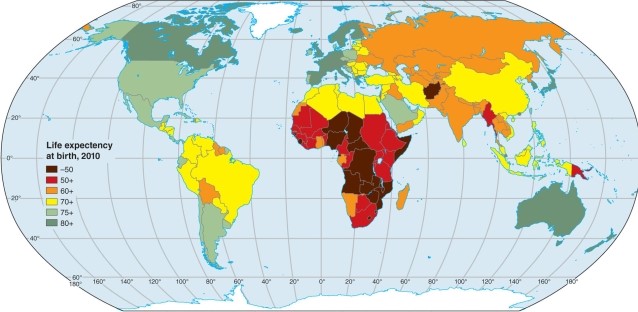
A)characteristics of a country with low expectancy.
B)traits in common with Western Europe.
C)a pattern that is not like that of the United States.
D)traits in common with central Africa.

A)characteristics of a country with low expectancy.
B)traits in common with Western Europe.
C)a pattern that is not like that of the United States.
D)traits in common with central Africa.

Unlock Deck
Unlock for access to all 40 flashcards in this deck.
Unlock Deck
k this deck
9
When one compares Africa and South America on the total fertility rate map, one comes to the conclusion that 
A)Africa has the higher TFR overall.
B)South America has the higher fertility overall.
C)Both are about the same in total fertility.
D)Neither has the highest TFR in terms of world regions. Scrambling: Locked

A)Africa has the higher TFR overall.
B)South America has the higher fertility overall.
C)Both are about the same in total fertility.
D)Neither has the highest TFR in terms of world regions. Scrambling: Locked

Unlock Deck
Unlock for access to all 40 flashcards in this deck.
Unlock Deck
k this deck
10
In population Australia is notable
A)because it is about as densely populated as Europe.
B)its arithmetic density overall is moderately high.
C)since it rivals Japan and China in population total numbers.
D)as it is virtually empty of population except in some coastal areas.
A)because it is about as densely populated as Europe.
B)its arithmetic density overall is moderately high.
C)since it rivals Japan and China in population total numbers.
D)as it is virtually empty of population except in some coastal areas.

Unlock Deck
Unlock for access to all 40 flashcards in this deck.
Unlock Deck
k this deck
11
Immediately after the industrial revolution which of the following applied to population dynamics first?
A)birth rates increased because people wanted more children in factory environments.
B)birth rates declined because agricultural pursuits were expanding.
C)death rates declined because of better water systems and health care.
D)death rates increased because of industrial accidents.
A)birth rates increased because people wanted more children in factory environments.
B)birth rates declined because agricultural pursuits were expanding.
C)death rates declined because of better water systems and health care.
D)death rates increased because of industrial accidents.

Unlock Deck
Unlock for access to all 40 flashcards in this deck.
Unlock Deck
k this deck
12
World population did not begin to rise rapidly until
A)The year 0 by the Christian calendar.
B)About the year 1,000, or the middle ages.
C)a logarithmic rise about 1970.
D)the beginning of the new millennium in 2000.
A)The year 0 by the Christian calendar.
B)About the year 1,000, or the middle ages.
C)a logarithmic rise about 1970.
D)the beginning of the new millennium in 2000.

Unlock Deck
Unlock for access to all 40 flashcards in this deck.
Unlock Deck
k this deck
13
Most of the population of the United States can be considered to be
A)located in the eastern regions along coasts and Great Lakes.
B)spread centrally in an area spreading out away from about Kansas City.
C)centered mostly in California and diminishing eastward.
D)focused mainly in Florida and diffusing northward along the coasts.
A)located in the eastern regions along coasts and Great Lakes.
B)spread centrally in an area spreading out away from about Kansas City.
C)centered mostly in California and diminishing eastward.
D)focused mainly in Florida and diffusing northward along the coasts.

Unlock Deck
Unlock for access to all 40 flashcards in this deck.
Unlock Deck
k this deck
14
Mexico City is one of the largest cities on the planet.Its location is
A)mainly along the eastern coast, linked to the Caribbean Sea.
B)central in a valley in a mountainous region.
C)centered mostly with Acapulco on the western coast.
D)in industrial 'maquiladora' lands bordering the United States.
A)mainly along the eastern coast, linked to the Caribbean Sea.
B)central in a valley in a mountainous region.
C)centered mostly with Acapulco on the western coast.
D)in industrial 'maquiladora' lands bordering the United States.

Unlock Deck
Unlock for access to all 40 flashcards in this deck.
Unlock Deck
k this deck
15
Lighter colors on the maps of world population in the text
A)show areas of higher/denser human population.
B)show areas of lower/less dense human population.
C)coincide with tropical climate regions.
D)coincide with areas of coniferous forest.
A)show areas of higher/denser human population.
B)show areas of lower/less dense human population.
C)coincide with tropical climate regions.
D)coincide with areas of coniferous forest.

Unlock Deck
Unlock for access to all 40 flashcards in this deck.
Unlock Deck
k this deck
16
The first locations for wide spread domestication of plants would have been
A)The Fertile Crescent.
B)What is today Iraq and Syria.
C)Mesopotamia (around the Tigris and Euphrates Rivers).
D)All of the above are true regarding plant domestication. Scrambling: Locked
A)The Fertile Crescent.
B)What is today Iraq and Syria.
C)Mesopotamia (around the Tigris and Euphrates Rivers).
D)All of the above are true regarding plant domestication. Scrambling: Locked

Unlock Deck
Unlock for access to all 40 flashcards in this deck.
Unlock Deck
k this deck
17
According to the map, the Black Death (the Bubonic Plague) originated 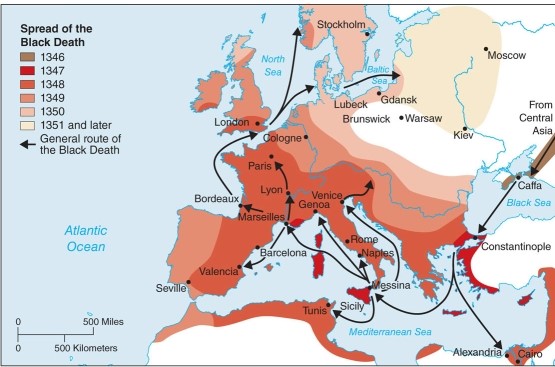
A)in central Asia.
B)in the eastern Mediterranean Sea area.
C)in central Europe.
D)in the Baltic Sea area.

A)in central Asia.
B)in the eastern Mediterranean Sea area.
C)in central Europe.
D)in the Baltic Sea area.

Unlock Deck
Unlock for access to all 40 flashcards in this deck.
Unlock Deck
k this deck
18
Over the last 100 years, the city of Las Vegas has taught us that
A)cities in the desert should be abandoned because they cannot last.
B)water provided to desert communities helps them to grow greatly.
C)building large dams is best for industrialized countries.
D)its moist Mediterranean climate has helped it to grow.
A)cities in the desert should be abandoned because they cannot last.
B)water provided to desert communities helps them to grow greatly.
C)building large dams is best for industrialized countries.
D)its moist Mediterranean climate has helped it to grow.

Unlock Deck
Unlock for access to all 40 flashcards in this deck.
Unlock Deck
k this deck
19
Denser population regions in Europe
A)are found more northward away from the Mediterranean.
B)are in areas where the industrial revolution started first in the world.
C)coincide with moist marine west coast climate.
D)all of the above apply. Scrambling: Locked
A)are found more northward away from the Mediterranean.
B)are in areas where the industrial revolution started first in the world.
C)coincide with moist marine west coast climate.
D)all of the above apply. Scrambling: Locked

Unlock Deck
Unlock for access to all 40 flashcards in this deck.
Unlock Deck
k this deck
20
Within the crude birth rates map, the lowest rates are in 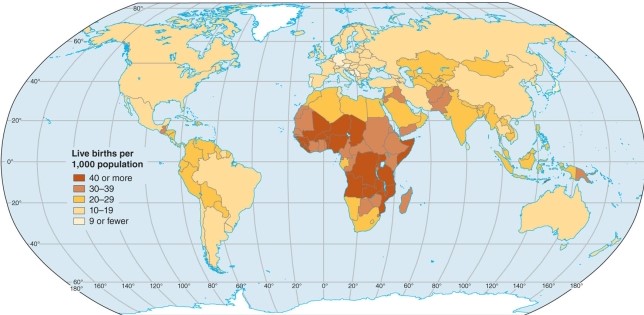
A)central Africa.
B)central Europe.
C)central America.
D)central Asia.

A)central Africa.
B)central Europe.
C)central America.
D)central Asia.

Unlock Deck
Unlock for access to all 40 flashcards in this deck.
Unlock Deck
k this deck
21
Africa, generally, has the highest infant mortality rates.There is one country outside of Africa with very high rates.It would be
A)a country experiencing warfare recently.
B)a country that otherwise has much industry and development.
C)a country in Europe.
D)a country similar to Australia in development and culture.
A)a country experiencing warfare recently.
B)a country that otherwise has much industry and development.
C)a country in Europe.
D)a country similar to Australia in development and culture.

Unlock Deck
Unlock for access to all 40 flashcards in this deck.
Unlock Deck
k this deck
22
The demographic transition model is based
A)on the idea that population for a country stays the same over time.
B)on many factors, but mainly that agriculture in the basis for growth in most areas.
C)on the pattern seen in Europe.
D)on military activity of many countries.
A)on the idea that population for a country stays the same over time.
B)on many factors, but mainly that agriculture in the basis for growth in most areas.
C)on the pattern seen in Europe.
D)on military activity of many countries.

Unlock Deck
Unlock for access to all 40 flashcards in this deck.
Unlock Deck
k this deck
23
A country like the UAE (United Arab Emirates) shows a unique population pyramid
A)in that it is an extreme pyramid.
B)it is a top shape with more elderly as people live longer in the middle east.
C)it is imbalanced with more males coming in to work.
D)it has gashes (indentations) in the male population from war.
A)in that it is an extreme pyramid.
B)it is a top shape with more elderly as people live longer in the middle east.
C)it is imbalanced with more males coming in to work.
D)it has gashes (indentations) in the male population from war.

Unlock Deck
Unlock for access to all 40 flashcards in this deck.
Unlock Deck
k this deck
24
The main trait of stage two of the demographic transition involves
A)increasing total population.
B)decreasing death rates.
C)more industry in a country.
D)all of the above. Scrambling: Locked
A)increasing total population.
B)decreasing death rates.
C)more industry in a country.
D)all of the above. Scrambling: Locked

Unlock Deck
Unlock for access to all 40 flashcards in this deck.
Unlock Deck
k this deck
25
Thomas Malthus's rather deterministic view of population
A)stated that increase would lead to poverty and war.
B)depended on environmental factors like precipitation and soil quality.
C)was focused on the idea that technology would increase food production.
D)agreed with Carl O.Sauer's views of landscape morphology.
A)stated that increase would lead to poverty and war.
B)depended on environmental factors like precipitation and soil quality.
C)was focused on the idea that technology would increase food production.
D)agreed with Carl O.Sauer's views of landscape morphology.

Unlock Deck
Unlock for access to all 40 flashcards in this deck.
Unlock Deck
k this deck
26
In the demographic transition the greatest growth is found in
A)Stage 1.
B)Stage 2.
C)Stage 3.
D)Stage 4.
A)Stage 1.
B)Stage 2.
C)Stage 3.
D)Stage 4.

Unlock Deck
Unlock for access to all 40 flashcards in this deck.
Unlock Deck
k this deck
27
Doubling time is ascertained by
A)subtracting the death rate from the birth rate.
B)multiplying the RNI by infant mortality.
C)inferring that TFR is greater year by year.
D)dividing the RNI by the constant of 70.
A)subtracting the death rate from the birth rate.
B)multiplying the RNI by infant mortality.
C)inferring that TFR is greater year by year.
D)dividing the RNI by the constant of 70.

Unlock Deck
Unlock for access to all 40 flashcards in this deck.
Unlock Deck
k this deck
28
A difference between Malthusian belief and those of neo-Malthusians is that
A)Malthus was a statistician while newer beliefs involve religious creeds.
B)the latter take into account the environment.
C)food production as a result of land survey systems was relevant to Malthus.
D)Malthus saw much food in the end-while neo-Malthusians do not.
A)Malthus was a statistician while newer beliefs involve religious creeds.
B)the latter take into account the environment.
C)food production as a result of land survey systems was relevant to Malthus.
D)Malthus saw much food in the end-while neo-Malthusians do not.

Unlock Deck
Unlock for access to all 40 flashcards in this deck.
Unlock Deck
k this deck
29
With lower and lower RNI worldwide
A)disease will still be a main problem in Europe and other developed countries.
B)the earth will still add a billion people to its population every 20 years or so.
C)population growth will virtually stop as most people do not have children.
D)population in China will continue to increase dramatically because of the government's one-child policy.
A)disease will still be a main problem in Europe and other developed countries.
B)the earth will still add a billion people to its population every 20 years or so.
C)population growth will virtually stop as most people do not have children.
D)population in China will continue to increase dramatically because of the government's one-child policy.

Unlock Deck
Unlock for access to all 40 flashcards in this deck.
Unlock Deck
k this deck
30
Over the last half century rates of natural increase (RNI) have
A)increased significantly.
B)stayed about the same.
C)declined significantly.
D)increased only in the third world.
A)increased significantly.
B)stayed about the same.
C)declined significantly.
D)increased only in the third world.

Unlock Deck
Unlock for access to all 40 flashcards in this deck.
Unlock Deck
k this deck
31
Which is the best real world example backing Ester Boserup's ideas?
A)German neo-Nazi agricultural intelligence.
B)Making soil out of moon dust.
C)The Green Revolution producing better crops in India.
D)Monsanto's genetically altered crops being rejected around the world.
A)German neo-Nazi agricultural intelligence.
B)Making soil out of moon dust.
C)The Green Revolution producing better crops in India.
D)Monsanto's genetically altered crops being rejected around the world.

Unlock Deck
Unlock for access to all 40 flashcards in this deck.
Unlock Deck
k this deck
32
Rates of natural increase have declined significantly in recent decades due to
A)better public health, medicine, and access to contraceptives.
B)better provision of soy milk and other grain based foods.
C)an increase in sexual reproduction.
D)more countries outlawing having certain numbers of children.
A)better public health, medicine, and access to contraceptives.
B)better provision of soy milk and other grain based foods.
C)an increase in sexual reproduction.
D)more countries outlawing having certain numbers of children.

Unlock Deck
Unlock for access to all 40 flashcards in this deck.
Unlock Deck
k this deck
33
One trait of the more developed and industrialized first world countries of the world is that
A)they have more younger children to care for.
B)they have increasingly more elderly people to care for.
C)they have about equal numbers of elderly and young to care for.
D)they have nearly the same kinds of population structure as poorer third world countries.
A)they have more younger children to care for.
B)they have increasingly more elderly people to care for.
C)they have about equal numbers of elderly and young to care for.
D)they have nearly the same kinds of population structure as poorer third world countries.

Unlock Deck
Unlock for access to all 40 flashcards in this deck.
Unlock Deck
k this deck
34
Population pyramids of developing, poorer countries reveal
A)an extreme pyramid shape with many children and few elderly.
B)a column shape with the same numbers overall represented in all age groups.
C)a top shape with many elderly and few children.
D)a mildly shaped pyramid with fewer children being born.
A)an extreme pyramid shape with many children and few elderly.
B)a column shape with the same numbers overall represented in all age groups.
C)a top shape with many elderly and few children.
D)a mildly shaped pyramid with fewer children being born.

Unlock Deck
Unlock for access to all 40 flashcards in this deck.
Unlock Deck
k this deck
35
The demographic transition starts with ____________ and ends with ____________.
A)death;life.
B)little growth;little growth.
C)few children;many pregnancies.
D)happiness;desolation.
A)death;life.
B)little growth;little growth.
C)few children;many pregnancies.
D)happiness;desolation.

Unlock Deck
Unlock for access to all 40 flashcards in this deck.
Unlock Deck
k this deck
36
Based on the U.S.map of mortality rates for heart disease, one could say 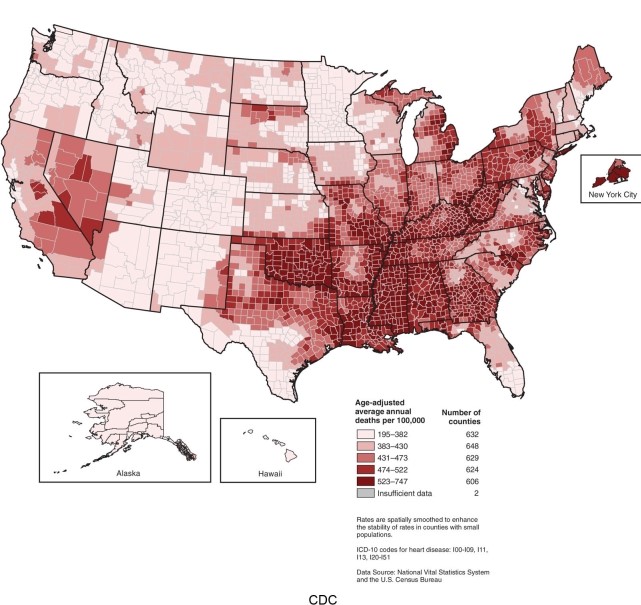
A)that the rates are about the same all across the county.
B)that the rates seem higher in coastal regions to the east and west.
C)that the rates are higher in the deep south to southern Great Plains.
D)that the rates are higher in dominantly Roman Catholic and Mormon areas.

A)that the rates are about the same all across the county.
B)that the rates seem higher in coastal regions to the east and west.
C)that the rates are higher in the deep south to southern Great Plains.
D)that the rates are higher in dominantly Roman Catholic and Mormon areas.

Unlock Deck
Unlock for access to all 40 flashcards in this deck.
Unlock Deck
k this deck
37
Based on the map of infant mortality rates, China 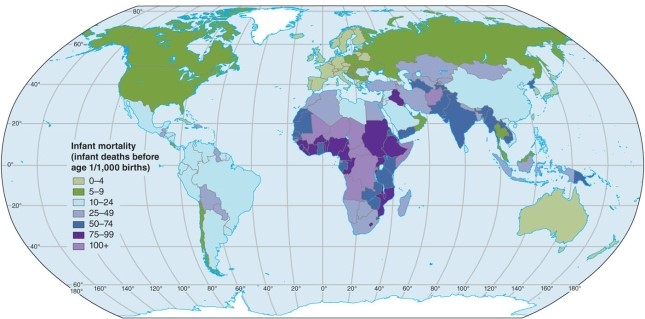
A)has about the highest mortality in the world.
B)is in the lowest category of mortality in the world.
C)is shown with a greatly varied mortality within its borders.
D)has about the same mortality rate as India.

A)has about the highest mortality in the world.
B)is in the lowest category of mortality in the world.
C)is shown with a greatly varied mortality within its borders.
D)has about the same mortality rate as India.

Unlock Deck
Unlock for access to all 40 flashcards in this deck.
Unlock Deck
k this deck
38
If the CBR = 40 and the CDR = 10, then the RNI
A)would be relatively low.
B)would not exist since growth would be in the negative.
C)would equal the doubling time of the population.
D)would be relatively high.
A)would be relatively low.
B)would not exist since growth would be in the negative.
C)would equal the doubling time of the population.
D)would be relatively high.

Unlock Deck
Unlock for access to all 40 flashcards in this deck.
Unlock Deck
k this deck
39
CBR-CDR =
A)RNI.
B)TFR.
C)Doubling time in total population.
D)General ending time of an industrial revolution.
A)RNI.
B)TFR.
C)Doubling time in total population.
D)General ending time of an industrial revolution.

Unlock Deck
Unlock for access to all 40 flashcards in this deck.
Unlock Deck
k this deck
40
The mortality rates figure shows countries with the highest rates outside of Africa. Those countries are 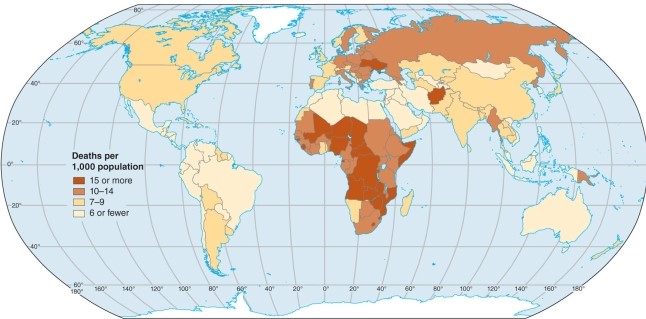
A)Ukraine and Afghanistan.
B)Morocco and Madagascar.
C)Bolivia and Paraguay.
D)Australia and New Zealand.

A)Ukraine and Afghanistan.
B)Morocco and Madagascar.
C)Bolivia and Paraguay.
D)Australia and New Zealand.

Unlock Deck
Unlock for access to all 40 flashcards in this deck.
Unlock Deck
k this deck



